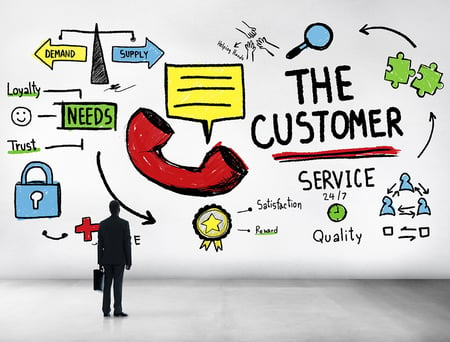There seems to be a set of stars aligning in my life lately. In the past week, I've had the opportunity to interview Joey Coleman on the Wayfinding Growth podcast about creating a great customer experience for your business.

It was amazing!
Then, later in the week, I got a block of time with Michael Redbord from HubSpot to record two episodes of Sprocket Talk, our HubSpot specific channel. Our conversation centered around customer service and HubSpot’s new Service Hub.
Again, I think someone is trying to tell me something here. I always thought I provided great customer service, and I still do, but my eyes are open to how much better it could be!
In this article, I am going to summarize some of the main points that Michael made in our interview, as well as where it took my mind.
Feel free to watch the episode here first or just read on.
Before we dive into the rest of the article, you might want to get to know Michael a bit more. I mean, I did reach out to him for a reason.
Michael Redbord’s career at least for the past eight years has been spent providing customer service at Hubspot. When we say service, we mean working in, working on and running the service department.

Michael has been in the trenches of customer service for HubSpot since they were a small company till today. Heck, many of you reading this may have talked to Michael at one point or time with your own HubSpot woes.
By the way, HubSpot hasn’t been a small company for a long time. However, Michael understands customer service departments both small and large because of his journey.
HubSpot has service teams with general consultants and implementation professionals. Michael humbly stated that he basically spent the last eight years of his professional life building Hubspot’s service department into what it is today.
Of course, he stated, this was only possible with help from his amazing team and co-workers!
It was fun to listen to him talk about his joy of joining HubSpot when they were a little baby company, with about 100 employees.
Living that journey, and leading that team until last year, really positioned him for his new role as part of the service hub product team.
Now, he gets to help build out the service hub product and help everybody learn from some of the mistakes, as well as the successes, that he addressed in HubSpot’s service department.
Getting Your Customer Service Department Started
One of the things I knew I wanted to achieve during this interview was create a starting point for companies that might not have a service department. So, I asked Michael the question, “How does a baby company, or a company that has not historically had a service department get started?”
Michael Redbord’s Answer: Service People vs. Service Department
I think every company is in the business of customer service.
Once you have your first customer, you have an obligation to that customer to serve them and deliver value. They gave you money, they were obviously looking for something in return.
On the flip side, If you're a business without a customer, (IS THAT EVEN POSSIBLE?) or maybe in a pre-revenue kind of situation, you may not need a customer service department. However, for anybody who actually has a customer, well then you're in the business of customer service, no matter what you do.
There may be different ways that different types of businesses actually work with customers, but for anybody that actually has customers, look around your business and ask yourself, what do I do when my customer has a question?
Do I, as the owner or executive handle the customer questions?
Or, does it go to somebody else, a person who wears a lot of hats. Do they do a little marketing and sales, a little bit of content development and a little bit of customer facing work?
In other words, because you're small, you make it work but it is not ideal. You don’t have the focus needed to create an amazing customer experience.
It’s good. It’s just maybe not great!
Bottom line: anybody in a business that has customers is doing something that is customer service.
It doesn't always exist as a department, but the motion exists. There is a functional element of customer service the moment you have a customer.
Because Michael went right to people who work in the walls of our companies, I asked him for his “good, better, best scenario” when it came to who needs to be on the customer service bus.
Your Customer’s Perspective
From a customer’s standpoint, there actually shouldn't be very much of a difference from a good, better, best scenario. Meaning, from the external perspective of how your customers feel about working with you as a customer, they shouldn’t know. Your customers should just be able to get what they need, when they need it, and there's lots of different ways to deliver that.
This got me thinking: You have to find what works for your company, your team and your customers. Building a customer service department is very unique to your business and what it provides to your customers.
Sometimes it's via email or phone calls, sometimes it's via chat or chat bot, but, the customer shouldn't have to worry about how your customer service team is organized.

I think this is worth saying.
Customers don't actually care about it. They just want what they want, when they want it.
Bonus tip: They want it now.
They also want customer service in a modern way.
Then, as you grow and customer service becomes a bigger component of what you do, there's different organizational structures, or ways, to think about people having different roles that make more sense within your customer service team.
When you're small, a lot of your customer service work tends to be done by your founders, owners or partners, and even sometimes done by the same people that are responsible for acquisition and sales. In the beginning, it gets all mixed together in a hodgepodge front-office-type of service department.
But over time, those customer service roles tend to get very specialized. You end up with somebody who's responsible for just project delivery, just onboarding or some other specific function. Those roles continue to get more and more specialized as you grow.
How they get specialized really depends on the nature of the business. But, the most important thing to remember, is that customers really don't care how you're set up. They just want what they want and they want it now!
What Should a Customer Service Department be Focused on?
When I asked Michael that question, I wasn’t sure what I was going to get. The answer was amazing. It made me think about how many businesses are tying their success into something as simple as action words. Here is what he had to say:
I'll use some verbs to answer this question.
- Engage
- Guide
- Grow
I think these are the verbs you need to engage with your customers when they want to engage with you. It's basically a way to react to them. After you have enough of customer engagements, you start to recognize some patterns.
I'm sure you guys watching this would say, “Well yeah, I sort of know how my clients behave.
I sort of know how my customers behave and most times I can anticipate their actions.”
The first step is just to engage and get out there and say, “Hey, you have a question, I'm going to give you an answer.”
The second step is to guide them more proactively and say, “Hey, you didn't have the question yet but you're going to have this question. We just know it. So, here is the answer.”
That is one small way to delight your customers.
If you can do that really well, you then get this cool opportunity for the third verb, which is to grow. And that's just a really cool situation in which a customer is happy and wants to start recommending you to their friends. It’s when they are focused on you and you on them, and as a result, you both grow together.
So let's say engage reactively, guide proactively and grow. There's lots of different ways to do each one of those series of tactics. But those are the three verbs.
Customer Service: Engage
Let's take the first verb engaged and unpack it a bit.
I think that a lot of the industries spend a lot of time thinking about this because it's so basic. Everyone needs to engage with their clients, with their customers and react to their questions.
Something that I think is really simple, the most basic version of this, is having a phone number for somebody to actually call and get in touch with you. A step up from that, in terms of complexity, is having an email address where you can be answering the questions your clients have and support them no matter what they are. A step up from that and a more modern solution, that people really like and businesses should be taking advantage of, is chatting and having a chat widget on the web site.
There's all sorts of other ways that even more sophisticated ways to engage with customers but those would be the three I encourage people to start with. It's phone, email and chat, those are the core service tools to get started with.
Who Should You Hire for Your Customer Service Department?
I was curious as to who might be a good fit as a customer service employee. I figured since Michael had taken HubSpot’s service department from something small to what it is today, he had to have done some hiring. So that’s what we dove into next:
I think that service people, when you think about that first service hire, have a different DNA, a different composition than a salesperson, which is different than an engineer or a marketer. Each one of those brings something a little different.
With the service person, the very first thing you want to hire for is not industry expertise.
A lot of folks say, “Oh, I need to hire somebody to work with my customers to do website redesigns. That of course must mean, I need to hire somebody that really knows website redesigns.” But I think you can teach somebody to be a website redesign expert or an expert in any other product or service. What you can't teach (most times) and I think the very, very most important thing to a customer service reps’ success is simply empathy.
You need to care and you need to be an empathetic person that wants to help other people get to their own goals. When you think of a service person, that's what they're there for. They're there to facilitate, to guide and to enable folks.
The number one thing to hire on is empathy, absolutely above everything else. Along with that, another two traits I think are really important, but probably kind of distant. They are process driven. A lot of this customer service stuff is repeated. So they need to enjoy building the process, tuning the process and following the process. They need to be outcome-oriented services, not just a fluffy job.
There are real outcomes associated with a customer’s success, real revenue and real scenarios that make or break the customer relationship. You need someone that can really turn the corner to drive outcomes. But again, I go back to first and foremost point, that they are empathetic. I think those are the three things I look for when making most service department hires.
Michael has hired hundreds of people at HubSpot into their service department, and helped other companies in the hiring process as well. My suggestion would be to follow his lead on these three main traits of a customer service rep.
Again those traits are:
- They are empathetic
- They are process-driven
- They are outcome-oriented
With this information, you can start to build an amazing customer service department for your business. If you already have a service department, use this information to gauge how equipped the current team is.
Customer service or customer experience should be a huge focus for your company. It is and always will be easier and more profitable to keep your current customer than it is to drum up new ones.
Stay tuned for more service and experience conversations coming soon. Want to keep learning? Then make sure you head over to the interview we did with Joey Coleman on the Wayfinding Growth podcast.
It will blow your mind!
Also, you might want to subscribe to our Sprocket Talk YouTube channel for more service, sales and marketing education.
Until next time, this is George B. Thomas saying, “Go out into the world and do some Happy HubSpotting!”






